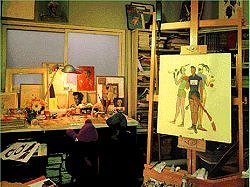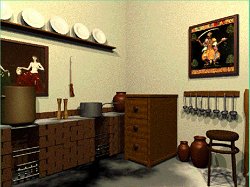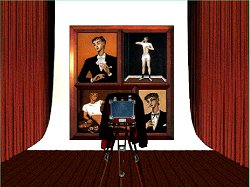|
Alice: An Interactive Museum
 Much sought after and virtually unobtainable, this interactive piece of multi-media comes from Haruhiko Shono, whose other works include Gadget and L-Zone. Together with composer Kazuhiko Kato, and artist Kuniyoshi Kaneko, he has produced a hunt through 12 thematic rooms in a museum for 53 playing cards. The rooms contain images and art inspired by Lewis Carroll's Alice in Wonderland, and some clearly inspired from elsewhere. Much sought after and virtually unobtainable, this interactive piece of multi-media comes from Haruhiko Shono, whose other works include Gadget and L-Zone. Together with composer Kazuhiko Kato, and artist Kuniyoshi Kaneko, he has produced a hunt through 12 thematic rooms in a museum for 53 playing cards. The rooms contain images and art inspired by Lewis Carroll's Alice in Wonderland, and some clearly inspired from elsewhere.
There are no hot cursors in this experience, but there are countless hot spots. All of them will produce a result, from the simple to the bizarre. Some will transport you to another room, others will turn your existing room upside down, quite literally. Others will link you to other images elsewhere in the room, which may in turn lead to your objective, one of the playing cards.
You don't have to find the cards in any particular order, and are free to wander through the rooms at will. Each card you find will have a message on the back, which will provide a clue to the whereabouts of another card, or to a broader aspect of the game.
 Finding particular cards requires the solving of puzzles and puzzle-like interactions, and interpreting the clues in the cards. Some clues are obvious, some less so. The cards are not all easy to find, and many hidden behind varying layers of interactivity. You will need perseverance to find your way through some of the interactive labyrinths.
Other than finding the cards, the object is to get out of the museum. You don't have to find all the cards to get out, but some cards are important to giving you clues about how to get out. Finding particular cards requires the solving of puzzles and puzzle-like interactions, and interpreting the clues in the cards. Some clues are obvious, some less so. The cards are not all easy to find, and many hidden behind varying layers of interactivity. You will need perseverance to find your way through some of the interactive labyrinths.
Other than finding the cards, the object is to get out of the museum. You don't have to find all the cards to get out, but some cards are important to giving you clues about how to get out.
There are over 200 pieces of art adorning the walls of the museum, and most of the cards will be found within and through this art. Some of the art is "grown-up", to say the least. In many you will find allusions to Alice, or fragments of particular scenes from Alice. Others are straight illustrations or images from the story. Some have nothing to do with Alice - or else the link escaped me.
Other homages to Alice can be found in other items within the rooms, and some of the more complex trails to a card were like following a rabbit down a hole. There is no doubt that an appreciation and an enjoyment of Alice will help you to enjoy this experience. In one sense your efforts to get out of the museum are akin to Alice's attempts to leave Wonderland.
 It's a tricky game to categorise. I thought Alice was far more game-like than Gadget, but it is not a standard game. Perhaps the boundaries of what constitutes a game need to be revised, but if you want a plot, with a beginning a middle and an end, an inventory, and hotspots, you won't find it here. It's most like a puzzle game, but not even that would accurately describe it. You don't even save games - next time you play just continue to look for the cards. When you find one, you don't take it with you, so there is no need to save. You can just mark it off your list.
You point and click your way around the museum, and click to interact with the images. As there are no hotpots, you will do a lot of clicking, but one of the appealing aspects for me was never being sure I had found everything in a picture. Many have far more than one interaction possible, and combinations of interactions will produce different results. These interactions provide the motion in the game; the rooms themselves are still.
It was not all aimless and random clicking either, although there was some of that to be sure. The clues in the cards provide trails to be followed, and what you are doing can have its own internal logic. A trail involving a menu is a case in point. It's a tricky game to categorise. I thought Alice was far more game-like than Gadget, but it is not a standard game. Perhaps the boundaries of what constitutes a game need to be revised, but if you want a plot, with a beginning a middle and an end, an inventory, and hotspots, you won't find it here. It's most like a puzzle game, but not even that would accurately describe it. You don't even save games - next time you play just continue to look for the cards. When you find one, you don't take it with you, so there is no need to save. You can just mark it off your list.
You point and click your way around the museum, and click to interact with the images. As there are no hotpots, you will do a lot of clicking, but one of the appealing aspects for me was never being sure I had found everything in a picture. Many have far more than one interaction possible, and combinations of interactions will produce different results. These interactions provide the motion in the game; the rooms themselves are still.
It was not all aimless and random clicking either, although there was some of that to be sure. The clues in the cards provide trails to be followed, and what you are doing can have its own internal logic. A trail involving a menu is a case in point.
Once I got to the final room, getting out proved a bit tricky. I found where to get out, but then there is a series of sequences that if you make an error will mean you have to start again. After a helpful nudge, and numerous attempts, I was outside, but the fun wasn't over. There are three "paths" to end the game, each worth taking.
Despite the "older" specifications, apart from having to turn down the resolution the game ran perfectly in Windows 98 on a PIII 800MHz. I couldn't do one puzzle, the image moving too fast on my computer, but tweaking the acceleration may resolve that.
According to the manual, which has a very helpful map of the layout of the museum, Kaneko not only did the art, but leant his culinary expertise to the menu of crustacean dishes, and apart from composing 18 pieces of music for the game, Kato is a renowned Japanese sommelier and provided the comments on the many wines to be found.
This is but another layer of this different and interesting offering.
Alice Screenshots courtesy of Jenny Guenther from Four Fat Chicks
Copyright © Steve Ramsey 2002.
All rights reserved.
System Requirements:
MS DOS 5 or higher, Windows 3.1 or higher (can't verify it plays on 2000 or XP but it was fine on 98) 33MHz 486 or higher, 8MB memory, 5MB disc space, 2x CD ROM, 640 x 480 display/256 colours
Mac
16MHz 68030 or higher (25MHz 68LC040 or higher recommended)
System 7 or higher, 5MB RAM, 2x CD ROM, 640 x 480 display/256 colours
|

